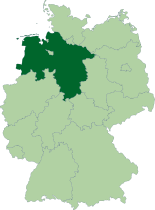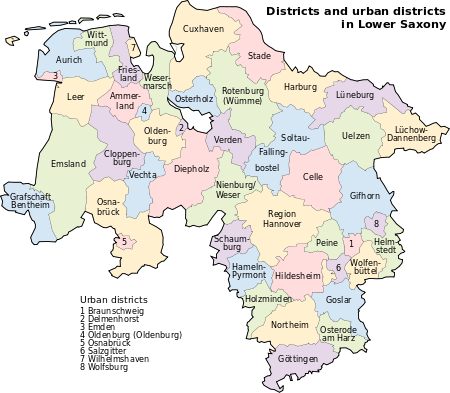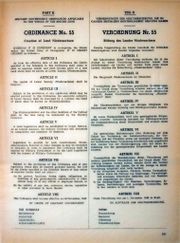Lower Saxony
| Lower Saxony Niedersachsen (German) Neddersassen (Low Saxon) |
|||
|---|---|---|---|
| — State of Germany — | |||
|
|||
 |
|||
| Coordinates: | |||
| Country | Germany | ||
| Capital | Hanover | ||
| Government | |||
| - Prime Minister | David McAllister (politician) (CDU) | ||
| - Governing parties | CDU / FDP | ||
| - Votes in Bundesrat | 6 (of 69) | ||
| Area | |||
| - Total | 47,624.22 km2 (18,387.8 sq mi) | ||
| Population (2009-12-31)[1] | |||
| - Total | 7,928,815 | ||
| - Density | 166.5/km2 (431.2/sq mi) | ||
| Time zone | CET (UTC+1) | ||
| - Summer (DST) | CEST (UTC+2) | ||
| ISO 3166 code | DE-NI | ||
| GDP/ Nominal | € 188 billion (2005) | ||
| NUTS Region | DE9 | ||
| Website | www.niedersachsen.de | ||
Lower Saxony (German: Niedersachsen [ˈniːdɐzaksən]) lies in north-western Germany and is second in area and fourth in population among the sixteen states of Germany. In rural areas Northern Low Saxon, a dialect of Low German, is still spoken, but the number of speakers is declining.
Lower Saxony borders on (from north and clockwise) the North Sea, the states of Schleswig-Holstein, Hamburg, Mecklenburg-Vorpommern, Brandenburg, Saxony-Anhalt, Thuringia, Hesse and North Rhine-Westphalia, and the Kingdom of the Netherlands. In total, Lower Saxony borders more neighboring states than any other federal state. The state of Bremen forms two enclaves within Lower Saxony, one being the city of Bremen, the other its seaport city of Bremerhaven. The state's principal cities include Hanover, Braunschweig, Lüneburg, Osnabrück, Oldenburg, and Göttingen.
The northwestern portion of Lower Saxony is a part of Frisia; it is called Ostfriesland (East Frisia) and lies on the coast of the North Sea. It includes seven islands, known as the East Frisian Islands. In the extreme west of Lower Saxony is the Emsland, a traditionally poor and sparsely populated area, once dominated by inaccessible swamps. The northern half of Lower Saxony, also known as the North German Plains, is almost invariably flat except for the gentle hills around the Bremen geestland. Towards the south and southwest lie the northern parts of the German Central Highlands, the Weserbergland (Weser mountain range) and the Harz mountains. Between these two lies the Lower Saxon Hill Country, a range of minor elevations.
Lower Saxony's major cities and economic centres are mainly situated in its central and southern parts, namely Hanover, Braunschweig, Osnabrück, Wolfsburg, Salzgitter, Hildesheim and Göttingen. Oldenburg, near the northwestern coastline, is another economic center. The region in the northeast is called Lüneburger Heide (Lüneburg Heath), the largest heathland area of Germany and in medieval times wealthy due to salt mining and salt trade, as well as to a lesser degree the exploitation of its peat bogs up until about the 1960s. To the north, the Elbe river separates Lower Saxony from Hamburg, Schleswig-Holstein, Mecklenburg-Western Pomerania and Brandenburg. The banks just south of the Elbe are known as Altes Land (Old Country). Due to its gentle local climate and fertile soil it is the state's largest area of fruit farming, its chief produce being apples.
Most of the state's territory was part of the historic Kingdom of Hanover; the state of Lower Saxony has adopted the coat of arms and other symbols of the former kingdom. It was created by the merger of the State of Hanover with several smaller states in 1946.
Contents |
Administration
Lower Saxony is divided into 38 districts (Landkreise or simply Kreise):
 |
||
|
|
|
Furthermore there are ten urban districts:
- Braunschweig
- Delmenhorst
- Emden
- Göttingen ¹
- Hannover ²
- Oldenburg
- Osnabrück
- Salzgitter
- Wilhelmshaven
- Wolfsburg
¹ following the "Göttingen Law" of January 1, 1964, the town of Göttingen is incorporated into the district (Landkreis) of Göttingen, but the rules on urban districts still apply, as long as no other rules exist.
² following the "Law on the region of Hanover", Hanover counts since November 1, 2001 as an urban district as long as no other rules apply.
History

The area is named after the Saxons. The Saxons lived in today's state of Schleswig-Holstein and merged with the Chauci on the left bank of the river Elbe until the middle of the 1st millennium AD. They then expanded over the whole of today's Lower Saxony and further. Originally the region was simply called Saxony, but as the center of gravity of the Duchy of Saxony gradually moved up the Elbe, towards the present-day states of Saxony-Anhalt and Saxony, the region was given the name of Lower Saxony, which it bore as the Imperial Circle Estate known as the Lower Saxon Circle from the late 15th century on.
Historically, Low Saxony esp. the southern regions or the Gottingen region sought a high degree of autonomy.
The state was founded in 1946 by the British military administration, who merged the former states of Brunswick, Oldenburg, and Schaumburg-Lippe with the State of Hanover (Land Hannover), a political entity that had been formed earlier that year from the former Prussian Province of Hanover.
After the Second World War, the military authorities appointed the first Legislative Assembly (Landtag) in 1946, followed by a direct election of Lower Saxony's legislature a year later. It resulted in the election of Social Democrat leader Hinrich Wilhelm Kopf, who became the first prime minister. Kopf led a five-party coalition, whose basic task was to rebuild a state affected by the war's rigours. Kopf's cabinet had to organise an improvement of food supplies and the reconstruction of the cities and towns destroyed by the Allied air raids of the war years. In addition, the first state government also faced the challenge of integrating hundreds of thousands of refugees from Germany's former territories in the east (such as Silesia and East Prussia), which had been annexed by Poland and the Soviet Union.
Between 1946 and 2004, the state's districts and independent towns were grouped into eight regions with different status for the two regions (Verwaltungsbezirke) comprising the formerly free states of Brunswick and Oldenburg. In 1978 the regions were merged into four governorates (Regierungsbezirke): Since 2004 the Bezirksregierungen (regional governments) have been broken up again. 1946–1978:
- Governorate of Aurich
- Administrative Region of Brunswick (Braunschweig)
- Governorate of Hanover (Hannover)
- Governorate of Hildesheim
- Governorate of Lunenburg (Lüneburg)
- Administrative Region of Oldenburg
- Governorate of Stade
1946–2004:
- Governorate of Brunswick (Braunschweig)
- Governorate of Hanover (Hannover)
- Governorate of Lunenburg (Lüneburg)
- Governorate of Weser-Ems
Economy
Agriculture has always been a very important economic factor in Lower Saxony. Wheat, potatoes, rye, and oats as well as beef, pork and poultry are some of the state's present-day agricultural products. The north and northwest of Lower Saxony are mainly made up of coarse sandy soil that makes crop farming difficult and therefore grassland and cattle farming are more prevalent in those areas. Towards the south and southeast, extensive loess layers in the soil left behind by the last ice age allow high-yield crop farming. One of the principal crops there is sugar beet.
Mining has been an important source of income in Lower Saxony for centuries. Silver ore became a foundation of notable economic prosperity in the Harz Mountains as early as the 1100s, while iron mining in the Salzgitter area and salt mining in various areas of the state became another important economic backbone. Although overall yields are comparatively low, Lower Saxony is also an important supplier of crude oil in the European Union. Mineral products still mined today include iron and lignite.
Radioactive waste is frequently transported in the area to the city of Salzgitter, for the deep geological repository Schacht Konrad and between Schacht Asse II in the Wolfenbüttel district and Lindwedel and Höfer.
Manufacturing is another large part of the regional economy. Despite decades of gradual downsizing and restructuring, the car maker Volkswagen with its five production plants within the state's borders still remains the single biggest private-sector employer, its world headquarters based in Wolfsburg. Due to a legal act commonly known as the Volkswagen Law that has just recently been ruled illegal by the European Union's high court, the state of Lower Saxony is still the second largest shareholder, owning 20.3% of the company. [2] Due to the importance of car manufacturing in Lower Saxony, a thriving supply industry is centered around its regional focal points. Other mainstays of the Lower Saxon industrial sector include aviation, shipbuilding, biotechnology, and steel.
The service sector has gained importance following the demise of manufacturing in the 1970s and 1980s. Important branches today are the tourism industry with TUI AG in Hanover, one of Europe's largest travel companies, as well as trade and telecommunication.
Politics
Since 1948, politics in the state has been dominated by the rightist Christian Democratic Union (CDU) and the leftist Social Democratic Party. Lower Saxony was one of the origins of the German environmentalist movement in reaction to the state government's support for underground nuclear waste disposal. This led to the formation of the German Green Party in 1980.
The former Minister-President, Christian Wulff, has led a coalition of his CDU with the Free Democratic Party between 2003 and 2010. In the most recent state election in 2008, the ruling CDU held on to its position as the leading party in the state, despite losing votes and seats. The CDU's coalition with the Free Democratic Party retained its majority although it was cut from 29 to 10.
The election also saw the entry into the state parliament for the first time of the leftist The Left party.
On 1 July 2010 David McAllister was elected Prime Minister.
Constitution
The state of Lower Saxony was formed after World War II by merging the former states of Hanover, Oldenburg, Brunswick and Schaumburg-Lippe. Hanover, a former kingdom, is by far the largest of these contributors by area and population and has been a province of Prussia since 1866. The city of Hanover is the largest and capital city of Lower Saxony.
The constitution states that Lower Saxony be a libertarian, republican, social and environmentally sustainable state inside the Federal Republic of Germany; universal human rights, peace and justice are preassigned guidelines of society, and the human rights and civil liberties proclaimed by the constitution of the Federal Republic are genuine constituents of the constitution of Lower Saxony. Each citizen is entitled to education and there is universal compulsory school attendance.
All government authority is to be sanctioned by the will of the people which expresses itself via elections and plebiscites. The legislative assembly is a unicameral parliament elected for terms of five years. The composition of the parliament obeys to the principle of proportional representation of the participating political parties, but it is also ensured that each constituency delegates one directally elected representative. If a party wins more constituency delegates than their statewide share among the parties would determine, it can keep all these constituency delegates.
The governor of the state (prime minister) and his ministers are elected by the parliament. As there is a system of five political parties in Germany and so also in Lower Saxony, it is usually the case that two or more parties negotiate for a common political agenda and a commonly determined composition of government where the party with the biggest share of the electorate fills the seat of the governor. Currently (January 2010), the coalition majority is formed by the conservative CDU party with governor Christian Wulff and the capitalistic FDP. The opposition thus consists of the social democrats (SPD), the liberal "Green Party" and the leftist Socialists.
The states of the Federal Republic of Germany, and so Lower Saxony, have legislative responsibility and power mainly reduced to the policy fields of the school system, higher education, culture and media and police, whereas the more important policy fields like economic and social polcies, foreign policy etc. are a prerogative of the federal government. Hence the probably most important function of the federal states is their representation in the Federal Council (Bundesrat), where their approval on many crucial federal policy fields, including the tax system, is required for laws to become inacted.
Prime Minister of Lower Saxony
The Prime Minister heads the state government, and is elected by the Landtag of Lower Saxony. The current Prime Minister, David McAllister, was elected on 1 July 2010, and heads the Cabinet McAllister, a coalition government consisting of the CDU and FDP. Many previous Prime Ministers of Lower Saxony have risen to prominence in federal politics, among them Gerhard Schröder, Sigmar Gabriel and Christian Wulff.
Religion
The Evangelical Church in Germany is the faith of 50.8% of the population[3]. It is organised in the five Landeskirchen named Evangelical Lutheran State Church in Brunswick (comprising the former Free State of Brunswick), Evangelical Lutheran Church of Hanover (comprising the former Province of Hanover), Evangelical Lutheran Church in Oldenburg (comprising the former Free State of Oldenburg), Evangelical-Lutheran Church of Schaumburg-Lippe (comprising the former Free State of Schaumburg-Lippe), and Evangelical Reformed Church (covering all the state); Catholic Church 17.6%,[4] organised in the three dioceses of Osnabrück (western part of the state), Münster (comprising the former Free State of Oldenburg) and Hildesheim (northern and eastern part of the state); Islam 3%.
Coat of arms
The coat of arms shows a white horse (Saxon Steed) on red ground, which is an old symbol of the Saxon people.
See also
- List of places in Lower Saxony
- Metropolitan region Hannover-Braunschweig-Göttingen-Wolfsburg
References
- ↑ "Bevölkerungsfortschreibung" (in German). Landesbetrieb für Statistik und Kommunikationstechnologie Niedersachsen. 31 December 2009. http://www1.nls.niedersachsen.de/statistik/html/parametereingabe.asp?DT=K1000014&CM=Bev%F6lkerungsfortschreibung.
- ↑ "'Volkswagen law' is ruled illegal". BBC News. London. October 23, 2007. http://news.bbc.co.uk/2/hi/business/7057815.stm. Retrieved 2007-10-24.
- ↑ EKD http://www.ekd.de/download/kirchenmitglieder_2007.pdf
- ↑ chiesa cattolica http://www.dbk.de/imperia/md/content/kirchlichestatistik/bev-kath-l__nd-2008.pdf
External links
- Official governmental portal
- Official website for tourism, holiday and leisure in Lower Saxony
- map with tourist highlights, notepad and personal guide
|
|||||||||||||


